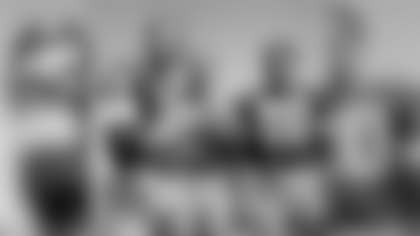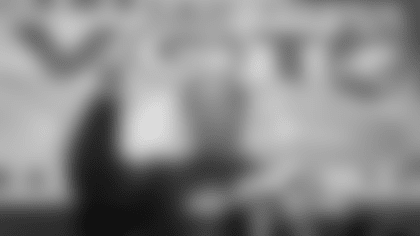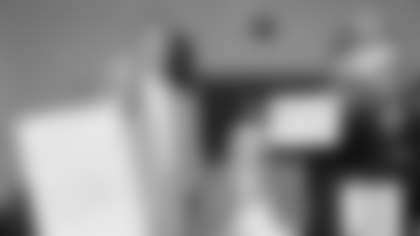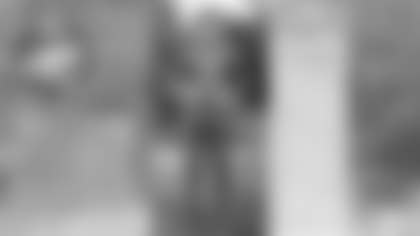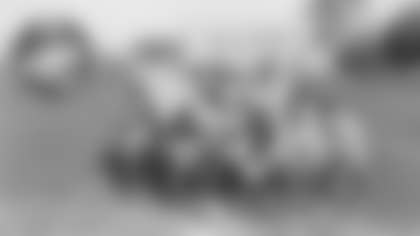Hayden from Carmel Valley, CA
I am a sports historian who finds some of the most niche and untold athletic stories in history and tries to add new, never-before-known information that has been lost to time. I am sure the subject of Dolly Gray is one you have been asked about plenty before. I have read your write-up on the situation, along with Bob Carroll's in-depth Coffin Corner piece on the St. Louis All-Stars and Ollie Kraehe. I consider these two works to be the most knowledgeable, accurate, and credible sources on the matter. Tragically, Bob is not around today. All this is to say: I don't think the mystery will ever be fully, no more doubts, closed case solved. Thus, I ask that if you have any sort of information at all on the story, please send it my way.
Hayden, I'm all but certain that you're right. The mystery of Dolly Gray's one-game stint with the Packers will never be solved. In fact, the more research I do, the more intrigued, but also the more baffled I become.
Truthfully, I've learned nothing more about the identity of the alleged Jack "Dolly" Gray, whose much ballyhooed signing with the Packers in 1923 ended within 10 days, than I did when I first wrote about him for a website post shortly after being named Packers historian a decade ago.
What's more, David Neft, who has undoubtedly done more research on the biographies of early NFL players than any pro football historian ever, hasn't uncovered anything more either. "I have no new info on him," Neft wrote in an email to me shortly after you submitted your question. He added, "He is absolutely not the player from Princeton and his true name is almost surely not Gray."
On Oct. 25, 1923, the lead headline on the Green Bay Press-Gazette's lone sports page ran over eight columns and read: "DOLLY GRAY, FAMOUS PRINCETON END, JOINS PACKERS."
The first paragraph of the story began: "Jack (Dolly) Gray, the famous Princeton end, who made three touchdowns against Chicago last year, in the much talked of intersectional game, had joined the Green Bay Packers and will be in uniform here Sunday against Racine." The Press-Gazette added that Gray was acquired from St. Louis, a new member of the NFL that season, after "several weeks of dickering."
The story further noted that Gray had played against the Packers when they faced the St. Louis All-Stars on Oct. 7, at Bellevue Park, in a game that ended in a 0-0 tie.
What have I learned since I first wrote about Gray 10 years ago?
Thanks to Ashley Augustyniak, reference services coordinator in Special Collections at the Princeton University Library, I've gathered more information about Howard Kramer Gray, the end who scored the game-winning touchdown on a fourth-quarter, 40-yard return of a fumble when Princeton edged the University of Chicago, 21-18, before an overflow crowd at Stagg Field on Oct. 28, 1922.
According to Princeton's records, Howard "Howdy" Gray attended the University of Nebraska College of Medicine in 1923. What's more, there's nothing in his records at Princeton that indicate he played football again after college.
Howard Gray became a noted abdominal surgeon at the Mayo Clinic and drowned in Lake Pepin in 1955 when he tried to swim after a small boat that had dislodged from his larger cabin cruiser. Gray was 54.
I believe, as Neft does, there's no way the player who signed with the Packers was the end for Princeton that made Walter Eckersall's second All-America team in 1922.
So who was he? Here's more of what I've found.
Although what's most problematic is not knowing for sure if Gray was his given last name or a pseudonym; another rub is that if his name was Gray, almost anyone bearing that name in the early 1900s could have been tagged with the nickname Dolly.
The reason being that "Goodbye, Dolly Gray" was the battle chant of American soldiers and sailors during the Spanish-American War of 1898; and as one newspaper back then noted there could be thousands of Dolly Grays across the United States, including women.
Then there's all the uncertainties about Gray's identity – or whatever his name was – when he played in St. Louis.
St. Louis was granted an NFL franchise on July 28, 1923, at a league meeting in Chicago. The team was organized by Ollie Kraehe, a native of St. Louis who had appeared in three games for the Rock Island Independents the season before, and was nicknamed the All-Stars. Beyond that, the team's life was brief. The All-Stars survived just one season, finishing 1-4-2 in what was then a 20-team NFL.
On Sept. 30, the All-Stars opened with a 25-0 victory over Murphysboro, Ill., in a non-league game. Murphysboro, which had a population at the time of about 10,000, is located at the southern tip of Illinois, on the Missouri border, almost 100 miles south of St. Louis.
Carbondale, Ill., was located less than 10 miles from Murphysboro, and the paper there, the Daily Free Press, reported two days before the game that Kraehe had signed Jack Gray, "a varsity end of last year's Princeton eleven."
The next day, the Press-Gazette reported, "Howard 'Dolly' Gray, regular left end on the Princeton varsity team of last season, is the latest addition to Ollie Kraehe's St. Louis professional football squad." The Press-Gazette added that Gray had arrived in St. Louis a week earlier and would start the next day against Murphysboro.
However, based on the starting lineup and substitutions listed in the St. Louis Star's summary, Gray didn't play against Murphysboro. Louis Honerkamp covered the game for the Star and noted in his story, "The eleven is in excellent condition with the exception of Gray, star performer of the end position…"
The St. Louis Post-Dispatch, on the other hand, made no mention of Gray in its short preview story the day before the game or in its short game story the day after.
The All-Stars' next game was their first league game, the one played against the Packers on Oct. 7. The morning of the game, the Post-Dispatch reported, "Bill Gray, former Princeton end, is also ready for the opening whistle."
Obviously, the three references in three different newspapers over the span of 10 days to Jack Gray, Howard Gray and Bill Gray raise suspicions. The stories also show how difficult fact-checking could be at times back then and suggested the writers might have remembered that a Gray starred in Princeton's victory over Chicago the season before but not much else about him, including his first name.
The outcome of the Packers vs. All-Stars game was a 0-0 tie.
The next day, the Press-Gazette listed Gray as the All-Stars' starting left end in its box score and noted in its story that the visitors' lineup was studded with All-Americans, Gray among them.
None of the St. Louis papers covered the game, but the Post-Dispatch and Star listed Gray as the starting left end in their summaries, and the Daily Globe-Democrat noted in the last graph of its story that "Jack Gray had his shoulder dislocated and had to be removed in the last quarter."
The Packers would finish that season with a 7-2-1 record and tie the Milwaukee Badgers for third place in the final NFL standings, yet settled for a tie with a first-year team that would finish in 14th place. Seemingly, the Packers would have known the listed name of the All-Stars' left end, especially if he played most of the game.
Thus, how could Curly Lambeau not know what kind of player he was getting when he acquired him less than three weeks later?
Total Football: The Official Encyclopedia of the National Football League and the Pro Football Reference website list Jack Gray as playing in five games in 1923: four with St. Louis and one with the Packers. But I could find Gray's name in only two other St. Louis box scores after he played in Green Bay for a total of three, not four.
Gray was listed in the Post-Dispatch as the starting left end when St. Louis tied the Hammond Pros, 0-0, on Oct. 14. The paper's game story also noted that Gray had broken through the line and hurried Hammond quarterback Swede Larson into missing a dropkick in the second quarter that could have made the score 3-0.
Before the game against Hammond, the Star's Honerkamp wrote in his preview story that "Jack Gray, who will be stationed at one of the ends, is as clever a flanker as the game has ever known."
Both the Post-Dispatch and Cleveland Plain Dealer also had Gray appearing as a substitute at right end in the All-Stars' 6-0 loss to the Cleveland Indians on Oct. 21.
Honerkamp traveled to Cleveland to cover the game for the Star and credited Gray with a tackle of Cleveland's Johnny Kyle following an interception in the final three-and-a-half minutes. Honerkamp described it as a "spectacular diving tackle." He also lauded six players on the All-Stars, including Gray, for being "outstanding."
That was Gray's last game in St. Louis.
For the record, I checked but didn't find his name in any of the St. Louis summaries after he had played with the Packers, either. The All-Stars played three games after that, losing to the Packers, 3-0, on Nov. 4 In a rematch at Sportsman's Park that drew roughly 750 fans; beating Jim Thorpe and the Oorang Indians, 14-7, on Nov. 11; and losing to the Badgers, 17-0, on Nov. 24.
Based on all of the above stories, it would be difficult to draw any conclusions about Gray's level of play. He started in two games and played in a third for the All-Stars, and they allowed a total of six points in those games.
In summary, there were plenty of questions raised but no answers.
What about the player's shoulder injury at the end of the game against Green Bay? He started the next week but could it have hampered him in the next two games? Was it even a legit injury? Did it affect his play in his one game with the Packers?
Did St. Louis, which drew fewer than 600 fans to its home opener against Hammond, simply use Gray and the storyline about him playing at Princeton as a publicity stunt to hype its games and hopefully draw bigger crowds? Or did the player using the name Gray simply outwit Kraehe when he signed him?
On Oct. 24, four days before the Badgers were scheduled to host the All-Stars and the day before the Packers announced they had acquired Gray, the Milwaukee Sentinel pumped up two of the St. Louis players. One was Eber Simpson, an Oshkosh, Wis., native and former University of Wisconsin standout, who was St. Louis' quarterback.
The other was Gray. "Jack (Dolly) Gray, last year's Princeton end, holds down one of the wing positions for St. Louis," the Sentinel's preview story read. "His playing has repeatedly featured the St. Louis games. Gray is one of the fastest men in professional football."
Apparently Gray being acquired by Green Bay was unbeknownst to many Milwaukee fans who cheered that Sunday believing they were seeing the former Princeton star, when it was actually another player who was the object of their affection. "(John) Cardwell was given an ovation by the crowd who thought he was Gray of Princeton," the Sentinel reported in its game story. "Gray did not accompany the All Stars (to) Milwaukee."
Actually, the morning of the game the Sentinel had reported that Gray, after playing three years at Princeton and being called by his coach Bill Roper "one of the greatest ends that ever wore the orange and black," had been obtained by the Packers in a deal with Kraehe.
"Gray played end with St. Louis against the Packers several weeks ago and he gave a bang up exhibition of football," the Sentinel stated. "He is the scrappy kind of a gridder who will fit in perfectly with the Packer machine. He is a perfect receiver of the forward pass and a brilliant defense player."
Here again, those stories raise nothing but more questions.
Was Gray, even if he was an imposter, talented enough to play pro football? Or were the sportswriters all guilty of puffery because they were clueless about his identity and believed he was the Gray who starred for Princeton no matter what his level of play was with the All-Stars? In other words, did he simply have everyone fooled, including not only writers but players and maybe even Kraehe and Lambeau?
On Oct. 28, in his one game with the Packers, Gray started at left end against the Racine Legion and was mentioned once in the Press-Gazette's play-by-play of the game for recovering a first-quarter fumble. However, the Packers lost 24-3, their worst defeat of the season. Two weeks earlier, they lost their other NFL game to the eventual second-place Chicago Bears, just 3-0.
Curiously, I was unable to find any mention in the St. Louis papers when the All-Stars shipped Gray to Green Bay. Nor did I find any mention in the Press-Gazette or the St. Louis papers when Gray and the Packers cut ties.
The next mention of Gray that I found in the Press-Gazette was in its 1934 tercentennial edition where Packers cofounder George Calhoun wrote his first in-depth history of the team. In summarizing the 1923 season, Calhoun wrote "a scoreless tie was played with St. Louis, the club that featured an alleged 'Dolly Gray,' famed Princeton star."
Then the name and story didn't resurface again – based on several newspapers.com searches – until Christmas Eve 1949, when a rumor spread like wildfire in Green Bay that Jack Mitchell, quarterback of Oklahoma's once-beaten champs of the then Big Seven Conference and the Packers' 14th-round draft pick as a future in 1947, was in Green Bay and hoping to talk to Lambeau about the team's quarterback woes.
The Packers were coming off a 3-9 finish, only their second losing season dating to their birth in 1919.
Someone claiming to be Mitchell called WJPG radio sportscaster Earl Gillespie and Press-Gazette sportswriter Lee Remmel to fuel the rumor. The same person also called Dr. M. E. McMillin, father-in-law of veteran Packers quarterback Jack Jacobs, looking to reconnect with Jacobs from their days together in Oklahoma.
Informed that Mitchell was in Green Bay, Packers team president Emil Fischer tried to track him down at the Northland Hotel.
The one doubter in the city, according to Art Daley, was Calhoun, who in 1923 had been the Packers' team secretary and the Press-Gazette's sports editor.
When Daley, the Press-Gazette's sports editor in 1949, was working on the Mitchell story, he informed Calhoun of the rumors. Calhoun's reaction? He "just shook his head," Daley wrote and then responded by saying, "That could be another Dolly Gray case."
After contacting Mitchell at his home in Arkansas City, Kan., Daley wrote a story squelching the rumors. Mitchell told Daley that he was happy coaching high school football in Blackwell, Okla., and wanted nothing to do with Green Bay. "Ah just can't stand that cold weather you people have up there," Mitchell told Daley.
After learning more about the Dolly Gray case from Calhoun, Daley wrote that, "Gray was not the eastern football hero the papers had said so much about." Calhoun told Daley, "He was just a punk using somebody else's name."
Daley concluded in that story, presumably based on what Calhoun told him, that "the hoax came to an end in Kansas City when the real Dolly Gray appeared." On that point, Calhoun's memory might be foggy. The Packers didn't play in Kansas City in 1923. They played there in 1924.
Moreover, it seems unlikely that the Packers would have traveled through Kansas City, located in western Missouri, to get to St. Louis in eastern Missouri when they played there on Nov. 4, a week after losing to Racine.
Then again, who knows for sure? After all, there is more evidence that Dolly Gray's fling with the Packers ended on that trip.
On July 8, 1961, while Calhoun was still living, the Press-Gazette wrote about the Dolly Gray affair in an editorial that addressed advancements made in mass communication and how the imposter "disappeared because the Packers were about to play in a city where the college player was known."
That aligns with what the paper reported at the time.
The Nov. 2, 1923, Press-Gazette listed Gray as one of 15 players that would be part of the Packers' traveling party when it pulled out of Green Bay shortly after midnight for the game the next day in St. Louis.
But Gray didn't play that Sunday and was never heard from again. His legacy is limited to one line on the Packers' all-time roster in their media guide. It reads: Gray, Jack (E), No college … 1923 … 1 (for games played).
Drew from Holmen, WI
Although Jim Thorpe began his football career in the 1910s, how many games did he face the Packers in the 1920s and beyond? I imagine he was quite the draw and teams were anxious to get him into their schedules for the gates he surely delivered.
Actually, the Packers never faced Jim Thorpe. He was 34 years old when the Packers joined the two-year-old American Professional Football Association in 1921. Thorpe came out of retirement and appeared in a final NFL game with the Chicago Cardinals in 1928, but it was against the Bears.
Thorpe played five games with the Cleveland Indians in 1921, 14 with the Oorang Indians over the 1922 and '23 seasons, nine games with Rock Island in 1924 and two more in 1925, when he also played three games for the New York Giants, and then nine games with the Canton Bulldogs in 1926.
The Packers did not play any of those teams in those seasons except for Rock Island in 1925. But Thorpe played his two games for the Independents against the Bears and Kansas City Cowboys.
But, Drew, you're right about Thorpe being a huge draw.
The Milwaukee Badgers faced Thorpe twice when he played with Oorang, a traveling team based in LaRue, Ohio. Both games were played in Milwaukee and drew crowds of 7,500 in 1922 and 4,000 in '23. The Racine (Wis.) Legion played against Thorpe twice when he was with Rock Island in 1924, and the game played in Racine drew an estimated crowd of 4,000.
Chuck from Richfield, WI
Do the Packers' two regular-season wins over Card-Pitt in 1944, when they won their sixth NFL championship, count as two wins each over the Cardinals and Steelers franchises in the all-time series records? Finally, I find it interesting that a tiny town like Green Bay was able to field a full team during this wartime period, while larger cities like Pittsburgh, Philadelphia and Chicago (Cardinals) needed to merge their rosters. How did we pull this off?
Based on the 2024 NFL Record & Fact Book, those games aren't counted in either series. Card-Pitt was a merger of the Chicago Cardinals and Pittsburgh Steelers for one year during World War II, and the Packers beat the combined team 34-7 in Green Bay and 35-20 in Chicago. I assume the NFL treats those two victories by the Packers the same way it does wins over defunct franchises, which are no longer included in its Record & Fact Book, either.
As for the second part of your question, Lambeau was as outspoken as any club official about continuing play during the war. As a result, I'm guessing he may have felt more compelled than anyone to find players who were exempt from service and able to play.
How did he do it?
One, the roster limit was 33 in 1942 and then reduced the next year to 28 for the duration of the war.
Thus, when the Packers opened preseason workouts on Aug. 9, 1942, a little more than eight months following the bombing of Pearl Harbor, there were only 28 players on hand, according to the Press-Gazette. Nevertheless, Lambeau was able to fill out the roster before the Sept. 27 opener.
At the beginning of the war, players who were married and fathers were classified 3A and not likely to be drafted. Among the players assigned that classification were some of Lambeau's best, including Charley Brock, Buckets Goldenberg, Don Hutson, Cecil Isbell, Russ Letlow, Baby Ray and George Svendsen. All of them are Packers Hall of Famers.
Three other future Packers Hall of Famers were Larry Craig, who was deferred because he operated a farm in South Carolina; Pete Tinsley, who served eight months in the Army but was honorably discharged due to chronic arthritis and ear trouble; and Joe Laws, who worked in the shipyards in Sturgeon Bay and was the father of four kids.
Something else Lambeau did in 1944, when the player shortage grew more acute, was to find local talent who could fill out the roster for preseason practices and games.
That year preseason practice started on Aug. 21 with 30 players, 17 of them rookies, but none of them draft picks. Of the Packers' 30 choices that year, only first-round pick Merv Pregulman ever played for them and his first season was 1946.
Rookie free agents signed by Lambeau to fill out his practice roster in 1944 included Hurley, Wisconsin's Len Calligaro, who played at the University of Wisconsin and had a deferment as an advanced student in agriculture at the school. Two others were in-state, small-school products: Bob McRoberts of what was then Stout Institute and Don Perkins of what was then Platteville State Teachers College. Dick Bilda of Milwaukee had played at Marquette University and Norm Tornow of Weyauwega, Wis., at Purdue.
Some of Lambeau's signees never played college ball. Norb Ebbers had played at Burlington (Wis.) High School and then with Kenosha's pro team in 1941; Ervin Dzierzewski was classified 4F and had played company ball for Falk Corp., in Milwaukee; and Walt Gudie was a product of La Crosse Central (Wis.) High School.
Only Bilda and Perkins made it.








